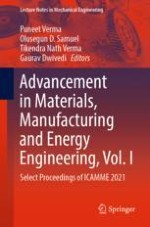This book (Vol. I) presents select proceedings of the conference on “Advancement in Materials, Manufacturing, and Energy Engineering (ICAMME 2021).” It discusses the latest materials, manufacturing processes, evaluation of materials properties for the application in automotive, aerospace, marine, locomotive, and energy sectors. The topics covered include advanced metal forming, bending, welding and casting techniques, recycling and re-manufacturing of materials and components, materials processing, characterization and applications, materials, composites and polymer manufacturing, powder metallurgy and ceramic forming, numerical modeling and simulation, advanced machining processes, functionally graded materials, non-destructive examination, optimization techniques, engineering materials, heat treatment, material testing, MEMS integration, energy materials, bio-materials, metamaterials, metallography, nanomaterial, SMART materials, bioenergy, fuel cell, and superalloys. The book will be useful for students, researchers, and professionals interested in interdisciplinary topics in the areas of materials, manufacturing, and energy sectors.
